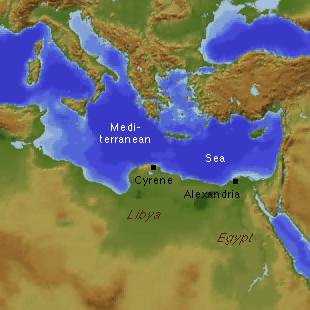
Greek colony in Lybia, existed from c. 631 BC to 642 AD.

Cyrene was founded in about 631 BC by emigrants from the Greek island of Thera. Their leader Battus established himself as king, and until c. 440 BC Cyrene was a city kingdom under the Battiad dynasty. The city florished economically, established a port at Appolonia (today's Marsa Susah) and the new towns of Barce (today's al-Marj) and Euhesperides, also called Berenice (today's Banghazi).
An influx of more Greek settlers around 570 BC brought conflict with the Libyans and between first inhabitants and new arrivals. Battus III tried to solve the situation by allowing a new constitution, but without much success. Eventually the reign of the Battiad dynasty came to an end and Cyrene became a republic.
For the next 200 - 250 years Cyrene did not distinguish itself from other small city states. Shortly before 300 BC it developed into an intellecutal centre comparable to the new Alexandria in Egypt. Its medical school was famous around the Mediterranean, and scientists, scholars and philosphers were attracted to it. Eratosthenes was born in Cyrene, and a new philosphical school known as the Cyrenaics developed. (The Cyrenaics held that one can know the existence of the world because of its effect on oneself but one cannot know anything about its nature. Two people could experience a thing and give it the same name but that is no proof of it having the same effect on them. As a consequence, the only justification for one's action could be pleasure; goodness is measured by the amount of pleasure it brings.)
In 96 BC Cyrene came under Roman rule. In 67 BC it was incorporated with Crete into a province with Cyrene as capital. Roman rule brought prosperity but was despised by the local jews, who ended it through an uprising in 115 AD. Cyrene declined thereafter; in 642 AD it was conquered by the Arabs and ceased to exist.

Today's ruins of Cyrene are in the area of the village of Shahhat in al-Jabal al-Akhdar. The excavations, which cover only a small part of the ancient city, consist of remains from Roman times, including a sanctuary of Apollo with statues of Venus and of Apollo, the city forum, a house from the 2nd century AD with exquisite mosaics, and a huge Doric column from a temple of Zeus from the 6th century BC.